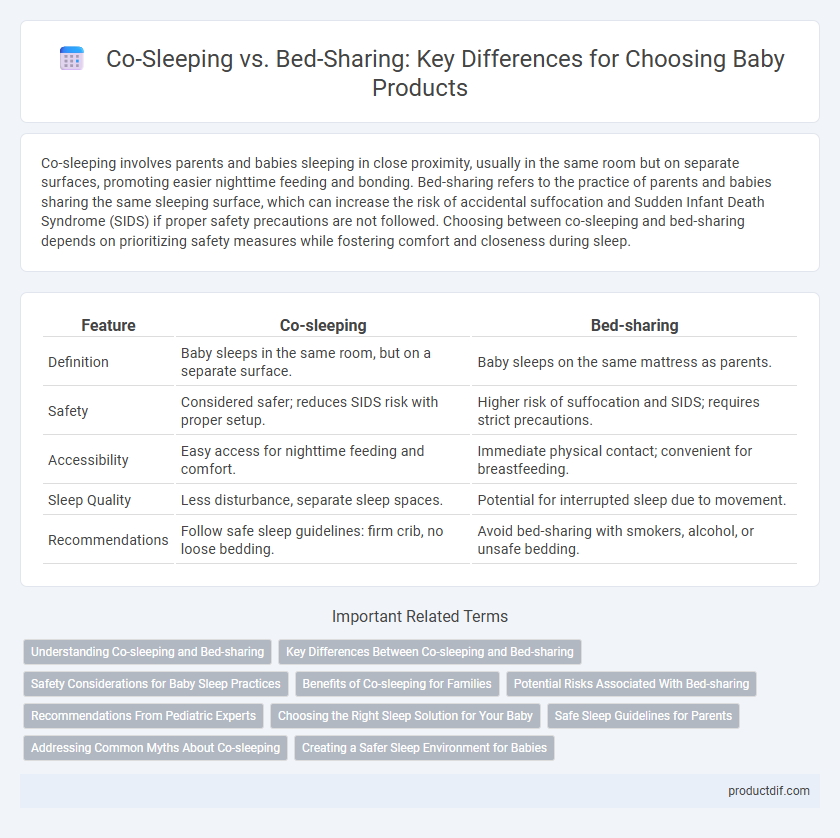Co-sleeping involves parents and babies sleeping in close proximity, usually in the same room but on separate surfaces, promoting easier nighttime feeding and bonding. Bed-sharing refers to the practice of parents and babies sharing the same sleeping surface, which can increase the risk of accidental suffocation and Sudden Infant Death Syndrome (SIDS) if proper safety precautions are not followed. Choosing between co-sleeping and bed-sharing depends on prioritizing safety measures while fostering comfort and closeness during sleep.
Table of Comparison
| Feature | Co-sleeping | Bed-sharing |
|---|---|---|
| Definition | Baby sleeps in the same room, but on a separate surface. | Baby sleeps on the same mattress as parents. |
| Safety | Considered safer; reduces SIDS risk with proper setup. | Higher risk of suffocation and SIDS; requires strict precautions. |
| Accessibility | Easy access for nighttime feeding and comfort. | Immediate physical contact; convenient for breastfeeding. |
| Sleep Quality | Less disturbance, separate sleep spaces. | Potential for interrupted sleep due to movement. |
| Recommendations | Follow safe sleep guidelines: firm crib, no loose bedding. | Avoid bed-sharing with smokers, alcohol, or unsafe bedding. |
Understanding Co-sleeping and Bed-sharing
Co-sleeping refers to parents and babies sleeping in close proximity, typically in the same room but on separate surfaces, promoting bonding and easier nighttime care. Bed-sharing involves the baby sharing the same sleep surface, such as an adult bed, which can enhance breastfeeding convenience but may carry increased risks like suffocation or SIDS if safety precautions are not followed. Understanding the distinctions between co-sleeping and bed-sharing helps parents make informed decisions based on safety guidelines and family preferences.
Key Differences Between Co-sleeping and Bed-sharing
Co-sleeping involves parents and babies sleeping in close proximity, often in the same room but on separate surfaces, while bed-sharing specifically refers to sharing the same sleep surface, such as a mattress. Bed-sharing carries a higher risk of accidental suffocation or overlay due to soft bedding and parental movement, whereas co-sleeping allows for a safer distance that reduces these risks. Understanding these distinctions is crucial for parents to balance bonding benefits with infant safety in sleep environments.
Safety Considerations for Baby Sleep Practices
Co-sleeping and bed-sharing present distinct safety considerations for infant sleep practices, with bed-sharing linked to an increased risk of Sudden Infant Death Syndrome (SIDS) and accidental suffocation. Safe co-sleeping environments prioritize a separate sleep surface near the caregiver, reducing hazards such as soft bedding, pillows, and overheating. Pediatric guidelines emphasize the importance of firm mattresses, absence of gaps, and avoiding substances like alcohol or sedatives to ensure infant safety in any shared sleep arrangement.
Benefits of Co-sleeping for Families
Co-sleeping promotes stronger emotional bonds between parents and infants by allowing easier nighttime breastfeeding and quicker responses to baby's needs, which enhances overall family well-being. This practice supports better sleep quality for both mother and child by minimizing disruptions and reducing parental stress. Studies also show co-sleeping can foster secure attachment, leading to improved cognitive and emotional development in babies.
Potential Risks Associated With Bed-sharing
Bed-sharing increases the risk of accidental suffocation, strangulation, and Sudden Infant Death Syndrome (SIDS) due to soft bedding, pillows, and adult movements. Infants sleeping on adult beds may also face hazards from entrapment between the mattress and headboard or wall. Pediatric experts recommend using a separate, firm sleep surface to mitigate these potential dangers and ensure safer infant sleep environments.
Recommendations From Pediatric Experts
Pediatric experts recommend co-sleeping with a separate sleep surface, such as a bassinet attached to the parents' bed, to reduce the risk of sudden infant death syndrome (SIDS). Bed-sharing, where the baby sleeps on the same surface as the parents, is associated with increased hazards including suffocation and overheating, and is generally discouraged by organizations like the American Academy of Pediatrics (AAP). To ensure safe sleep, experts emphasize placing infants on their backs on a firm mattress free of soft bedding, pillows, and toys.
Choosing the Right Sleep Solution for Your Baby
Choosing the right sleep solution for your baby involves understanding the distinctions between co-sleeping and bed-sharing. Co-sleeping allows the baby to sleep in the same room but on a separate surface, promoting safety and easy monitoring, while bed-sharing involves the baby sleeping on the same bed with parents, which may increase risks if not practiced safely. Prioritizing infant sleep safety guidelines, including firm mattresses and avoiding soft bedding, helps parents decide the best option to support healthy sleep patterns and reduce the risk of SIDS.
Safe Sleep Guidelines for Parents
Safe sleep guidelines recommend placing babies on their backs in a separate, firm sleep surface next to the parents' bed to reduce the risk of Sudden Infant Death Syndrome (SIDS). Bed-sharing increases the risk of accidental suffocation and overheating, especially when bedding or soft surfaces are involved. Parents should ensure the sleep environment is free of pillows, blankets, and toys, adhering to recommendations from the American Academy of Pediatrics for safe co-sleeping practices.
Addressing Common Myths About Co-sleeping
Co-sleeping and bed-sharing are often misunderstood, with myths suggesting that all forms of co-sleeping increase Sudden Infant Death Syndrome (SIDS) risk. Research from the American Academy of Pediatrics clarifies that safe co-sleeping practices, such as using a firm mattress and avoiding soft bedding, can reduce hazards while promoting bonding and breastfeeding. Proper education on safe co-sleeping guidelines is essential for dispelling fears and ensuring infant safety.
Creating a Safer Sleep Environment for Babies
Creating a safer sleep environment for babies involves understanding the distinctions between co-sleeping and bed-sharing, where co-sleeping allows the baby to sleep close by in a separate sleep surface, reducing the risk of accidental suffocation. Utilizing certified infant mattresses, breathable bedding, and ensuring the baby sleeps on a firm, flat surface in a smoke-free environment are essential safety measures endorsed by pediatric experts. Following guidelines from organizations such as the American Academy of Pediatrics significantly lowers the risk of Sudden Infant Death Syndrome (SIDS) and promotes safer sleep practices.
Co-sleeping vs Bed-sharing Infographic

 productdif.com
productdif.com